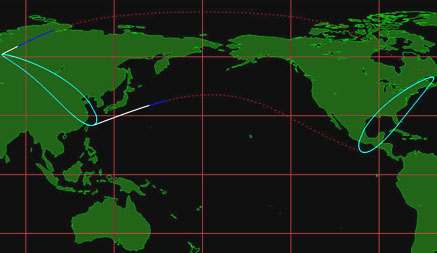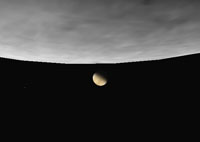Timing is everything for August 13th's occultation of Venus by a thin crescent Moon. It occurs in daylight for U.S. observers, but it should be spectacular before dawn on the 14th from Japan.
Last month observers in Europe and western Asia got their chance to watch a gorgeous occultation of Jupiter by a thin crescent Moon. Now skywatchers in North America will get their chance — this time involving a waning crescent and dazzling Venus.

A world map shows where August 13th's lunar occultation of Venus is visible. In eastern North America, both the disappearance and reappearance are visible west of a line roughly from the Great Lakes through New Orleans and Mexico City. In the Far East it occurs before dawn on August 14th.
Source: Occult 4
As the map here shows, the occultation is visible from a broad swath that begins in eastern Asia, spans the North Pacific Ocean (missing Hawaii), and ends along the Eastern Seaboard and locations adjacent to the Gulf of Mexico. The event begins about 17:45 Universal Time at its western limit and at roughly 21:30 UT near the eastern end. The International Occultation Timing Association has computed when Venus disappears and reappears for more than 700 cities.
This event's timing makes it a daylight event across North America. The Moon's waning crescent is only 15% sunlit, and ordinarily that would be enough to discourage even dedicated observers.
But right now Venus is separated from the Sun by nearly its maximum extent (46°), and the planet is so bright (magnitude –4.4) that finding it in a telescope should be fairly easy from most locations. In San Francisco, for example, Venus slips behind by the crescent Moon's bright limb at 1:28 p.m. with the pair 43° up in the western sky. (Sadly, where I am in rural Maine, the event begins with Venus just 2½° above the horizon — wish me luck!)

This simulation shows the half-lit disk of Venus just before it disappears behind the sunlit limb of a waning crescent Moon.
Source: Stellarium
However, it's an entirely different and more favorable situation for observers on the other side of the Pacific. From Tokyo, for example, the entire event is visible in a dark sky before dawn. The planet's half-lit disk disappears well above the predawn horizon at 3:46 a.m. local time on the 14th and dramatically reappears from behind the Moon's dark limb about 45 minutes later.
If you manage to capture this celestial showstopper — whether in daylight or in darkness — please consider posting your snapshots to our online image gallery.
 1
1









Comments
John Robbins
August 14, 2012 at 3:14 pm
Despite the presence of hazy skies and thin clouds, I successfully observed the daylight occultation of Venus by the moon on 13th Aug from Bellevue, WA. Once I located the moon with my naked eye, I pointed my telescope to the moon and could see both the moon and Venus in my telescope's finderscope. A few minutes later, bright venus slipped behind the moon's disc and was visible no longer. An hour later, I tried to see the reappearance of Venus, but the clouds had thickened to the point where I could no longer find the moon. Still, considering the less-than-ideal conditions, it was quite a successful observation.
You must be logged in to post a comment.
You must be logged in to post a comment.